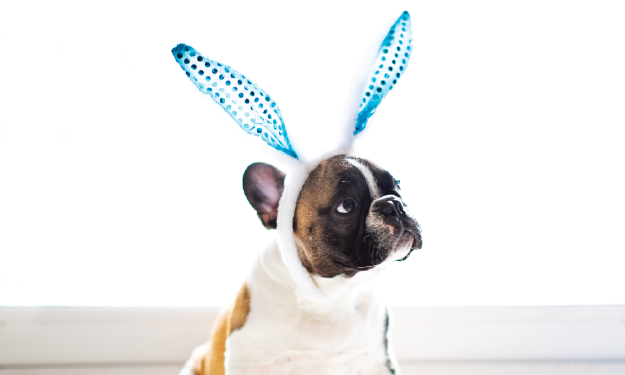Protect Your Pets on Easter: Beware of Easter Dog Poison Dangers

Easter is right around the corner, which means family time, egg hunts, good food, and a visit from the Easter bunny! Unfortunately this holiday brings many pet hazards as well. This is a time of celebration for most, but a time where we see an influx of animals visiting our ER due to two sneaky substances that we love and cherish in our homes on this holiday: chocolate and lilies. What is sometimes tasty to eat and beautiful to smell for us, is extremely dangerous for our pets.
Easter Lilies and Cats
The most common call the Pet Poison Helpline receives for cats is lily ingestion. These flowers are often given as gifts or bought for decoration around Easter and end up right on your dining room table or kitchen counter: where your cat can reach them!
What makes lilies toxic to cats?
The exact toxin in lilies that is poisonous to cats is unknown.
What part of lilies are toxic?
All parts of these beautiful plants are poisonous, including the leaves, pollen, stems, and flowers. It only takes 1-2 leaves, or just the pollen, to kill a cat or cause severe kidney failure. Common varieties include the Tiger, Day, Asiatic, Easter, and Japanese Show Lily.
Early Symptoms
- vomiting
- lethargy
- dehydration (not drinking or overly thirsty)
- not urinating or urinating too frequently
- inflammation of the pancreas
Severe (More Rare) Symptoms
- walking drunk
- disorientation
- tremors
- seizures
Symptoms are noticeable within 6 to 12 hours of ingestion and cause severe damage within 24 to 72 hours as kidney failure worsens.
How is it treated?
There is not an actual antedote. So, if you suspect your feline friend may have eaten any part of a lily, they need to be seen by a veterinary professional ASAP.
Treatments that can be administered are: induced vomiting, giving activated charcoal to bind the poison in the stomach and intestines, intravenous fluid therapy, kidney function monitoring tests, and supportive care. To ensure the best possible outcome for your cat, IV fluids should be started within 18 hours of ingestion.
Chocolate and Dogs
Coincidentally, chocolate is also the most common call the Pet Poison Helpline receives for dogs. The ASPCA also reports that they receive more calls from pet owners regarding chocolate ingestion on Easter than any other holiday, even Christmas and Halloween! With all those chocolate-filled Easter eggs around the house and yard, it’s just as much a game to seek them out for your dog as it is for your kids.
What makes chocolate toxic to dogs?
Chocolate contains an ingredient called theobromine, which is a distant cousin to caffeine. Dogs cannot process theobromine the same way humans can.
Check out our blog on chocolate poisoning in dogs.
What types of chocolate are toxic?
Darker chocolates such as Baker’s chocolate, semi-sweet chocolate, cocoa powder, and gourmet dark chocolates are highly dangerous in comparison to milk chocolate and white chocolate. Your dog’s weight and the amount they ate also plays a role in how much chocolate it takes to be dangerous for your pup.
Symptoms
- vomiting & diarrhea
- hyperactivity
- inflammation of the pancreas (i.e., pancreatitis)
- abnormal heart rhythms
- seizures
How is it treated?
Plans of action and treatment include inducing vomiting and usually administering multiple doses of activated charcoal to decontaminate or clean out the stomach/intestines. IV fluids are also administered to help with excretion. In some cases, sedatives may need to be given to calm the pet. If there is a high heart rate and blood pressure, the veterinarian may administer heart medications to reduce the rate and blood pressure. To curb seizures, an anti-convulsant can be given. To alleviate stomach discomfort and diarrhea, antacids like Pepcid may be given.
Other Common Easter Dangers for Pets
- Plastic Easter grass: commonly ingested by cats, and sometimes dogs, this stringy grass can get stuck in their GI tract.
- Fertilizers & herbicides: with spring coming, it’s time for some yard work but many of these chemicals can be harmful for your pet if ingested.
- Other candies containing xylitol: keep any and all sugar-free candy (jelly beans, gum, etc.) far away from pets, for they may contain the extremely toxic substance xylitol.
- Fatty foods: keep the fatty table scraps, like ham and lamb, away from pets to avoid life-threatening pancreatitis.
So, if you’re hiding Easter eggs or leaving out baskets from the Easter bunny, keep the eggs in high places and keep the baskets put away or covered. And please, opt for a flower bouquet without lilies. It is not worth it and your cat will likely seek them out for a good chew. Happy Easter!
Written by: Tracy McDonald